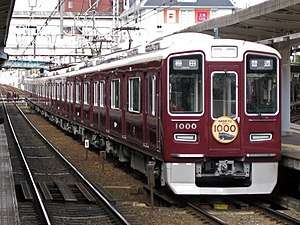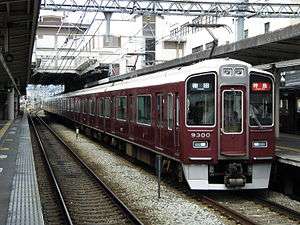Hankyu 1000 series
The Hankyu 1000 series (阪急電鉄1000系, Hankyū dentetsu 1000-kei) is a commuter electric multiple unit (EMU) train type operated by the private railway operator Hankyu Corporation on Hankyu Kobe Main Line services since November 2013, and on the Hankyu Takarazuka Main Line since December 2013.[1]
| Hankyu 1000 series | |
|---|---|
 Set 1000 in service, December 2013 | |
| In service | 28 November 2013 – |
| Manufacturer | Hitachi |
| Built at | Kudamatsu, Yamaguchi |
| Constructed | 2013– |
| Number built | 80 cars (10 sets) |
| Number in service | 80 cars (10 sets) |
| Formation | 8 cars per trainset |
| Fleet numbers | 1000– |
| Capacity | 1,022 per set |
| Operator(s) | Hankyu Corporation |
| Line(s) served | Hankyu Kobe Main Line Hankyu Takarazuka Main Line Nose Railway Myōken Line Nose Railway Nissei Line |
| Specifications | |
| Car body construction | Aluminium alloy, double-skin |
| Car length | 19,000 mm (62 ft 4 in) |
| Width | 2,770 mm (9 ft 1 in) |
| Height | 4,095 mm (13 ft 5.2 in) |
| Doors | 3 pairs of sliding doors per side |
| Maximum speed |
|
| Traction system | Variable frequency (IGBT) |
| Traction motors | Brushless electric motors (PMSM) |
| Acceleration | 2.6 km/h/s |
| Deceleration | 3.7 km/h/s (service) 4.2 km/h/s (emergency) |
| Electric system(s) | 1,500 V DC |
| Current collection method | Pantograph |
| Bogies | FS579M (motored), FS579T (trailer) |
| Braking system(s) | Electric commanding, regenerative brakes |
| Safety system(s) | ATS |
| Coupling system | Shibata-type |
| Track gauge | 1,435 mm (4 ft 8 1⁄2 in) |
Overview
Based on the 9000 series and 9300 series EMUs first introduced in 2003, the 8-car 1000 series trains are manufactured by Hitachi and have aluminium alloy bodies with a double-skin construction.[2] The trains are driven by fully enclosed permanent magnet synchronous motors (PMSM) supplied by Toshiba Corporation.[3] Externally, the trains are finished in the standard Hankyu colour scheme of all-over maroon.[2]
Formation
As of 1 April 2016, nine eight-car trains (units 1000 to 1008) were in service, formed as shown below, with four motored (M) cars and four non-powered trailer (T) cars.[4][5]
| Designation | Tc | M | M' | T | T | M | M' | Tc |
|---|---|---|---|---|---|---|---|---|
| Type | Tc1000 | M1500 | M'1600 | T1050 | T1050 | M1500 | M'1600 | Tc1100 |
| Numbering | 1000 | 1500 | 1600 | 1050 | 1150 | 1550 | 1650 | 1100 |
| Weight (t) | 29.8 | 36.7 | 33.3 | 25.9 | 25.9 | 36.7 | 33.3 | 29.8 |
| Capacity (total/seated) | 121/43 | 130/49 | 130/49 | 130/49 | 130/49 | 130/49 | 130/49 | 121/43 |
The "M" cars (1500 and 1550) each have two single-arm pantographs.[4]
Interior
Passenger accommodation consists of longitudinal bench seating throughout, with "golden olive" coloured moquette seat covers.[2] Internally, the trains use LED lighting throughout.[4] Each car includes a wheelchair space at one end.[4]
Passenger information is provided by 32-inch half-height LCD displays supplied by Toshiba Corporation,[3] with information provided in Japanese, English, Chinese, and Korean.[1]
- Train interior, December 2013
- LCD passenger information display, December 2013
History
The first set, 1000, underwent test running from October 2013.[6] It entered passenger service from 28 November 2013, following a special departure ceremony at Umeda Station.[1] The first Takarazuka Line set, 1001, entered service on 25 December 2013.[7]
Fleet history
The build details for the fleet are as shown below.[5]
| Set No. | Manufacturer | Date delivered | Allocation |
|---|---|---|---|
| 1000 | Hitachi | 19 November 2013 | Kobe Line |
| 1001 | Hitachi | 24 December 2013 | Takarazuka Line |
| 1002 | Hitachi | 14 July 2014 | Kobe Line |
| 1003 | Hitachi | 9 September 2014 | Takarazuka Line |
| 1004 | Hitachi | 9 April 2015 | Takarazuka Line |
| 1005 | Hitachi | 12 June 2015 | Kobe Line |
| 1006 | Hitachi | 4 September 2015 | Takarazuka Line |
| 1007 | Hitachi | 22 October 2015 | Kobe Line |
| 1008 | Hitachi | 29 January 2016 | Kobe Line |
| 1009 | Hitachi | June 2016[8] | Takarazuka Line[9] |
See also
- Hankyu 1300 series, a similar variant for use on the Kyoto Lines from 2014
References
- 阪急電鉄、新型車両1000系営業運転開始-ファンに見守られ梅田駅出発 [New Hankyu 1000 series trains enter service - Departure from Umeda Station seen off by railfans]. Umeda Keizai Shimbun (in Japanese). Japan: Riccrea, Inc. 28 November 2013. Retrieved 28 November 2013.
- 新型車両1000系・1300系をこの秋より導入します! [New 1000/1300 series trains to be introduced from autumn] (PDF). News release (in Japanese). Japan: Hankyu Corporation. 6 June 2013. Retrieved 7 June 2013.
- 阪急電鉄新型車両向け電気品受注について [Order for electrical equipment for new Hankyu trains]. Press release (in Japanese). Japan: Toshiba Corporation. 6 June 2013. Retrieved 7 June 2013.
- 阪急電鉄1000・1300系 [Hankyu 1000 & 1300 series]. Japan Railfan Magazine (in Japanese). Vol. 54 no. 634. Japan: Koyusha Co., Ltd. February 2014. pp. 69–75.
- 私鉄車両編成表 2016 [Private Railway Rolling Stock Formations - 2016] (in Japanese). Japan: Kotsu Shimbunsha. 25 July 2016. pp. 139–141. ISBN 978-4-330-70116-5.
- 阪急1000系の日中試運転が始まる [Daylight test-running of Hankyu 1000 series starts]. Japan Railfan Magazine Online (in Japanese). Japan: Koyusha Co., Ltd. 18 October 2013. Retrieved 18 October 2013.
- 阪急宝塚線で1000系1001編成が営業運転を開始 [1000 series set 1001 enters revenue service on the Hankyu Takarazuka Line]. Japan Railfan Magazine Online (in Japanese). Japan: Koyusha Co., Ltd. 26 December 2013. Retrieved 26 December 2013.
- 阪急1000系第10編成が陸送される [10th Hankyu 1000 series set delivered]. Japan Railfan Magazine Online (in Japanese). Japan: Koyusha Co., Ltd. 30 June 2016. Archived from the original on 22 August 2016. Retrieved 22 August 2016.
- 阪急1000系1009編成が宝塚線で営業運転を開始 [Hankyu 1000 series set 1009 enters service on Takarazuka Line]. Japan Railfan Magazine Online (in Japanese). Japan: Koyusha Co., Ltd. 21 August 2016. Archived from the original on 22 August 2016. Retrieved 22 August 2016.
External links
| Wikimedia Commons has media related to Hankyu 1000 series. |
- Official website (in Japanese)
